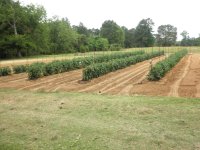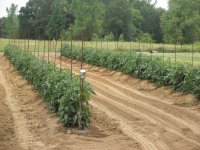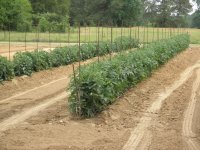Arkaybee
Silver Member
We thought we would plant some tomatoes again this year.
One row each of BIG BEEF, CELEBRITY, JETSETTER and SUNMASTER (49 plants per row/195 total). We selectded these varieties for their high disease resistance bred into them which we have to have down here in the southern heat and humidity; also for their exceptional flavor and acidity. Rows are about 80 feet long. Drip irrigation tube at the base of each row fed from a header tube (lay flat tubing) at the far end of the row. Pre-fertilized the ground two weeks prior to planting, incorporated the fertilizer with the tiller then threw up the rows with a three disc (three on each side) row-builder and leveled it off.
These photos are from a few weeks ago and the plants are now getting near the top of the stakes.
Seeds started indoors March 3 with bottom heat pad; germinated in 5 days; transplanted into individual cups after first true leaves appeared; planted into garden on April 13; first bloom appeared April 21; typically the first ripe fruit comes about 6 weeks after first bloom; I think the dryness and the excessive heat delayed the process this season because we picked the first ripe tomato June 8 and had enough to slice up for supper yesterday.
The deluge of ripe tomatoes is about to start so out goes the little HOMEGROWN TOMATOES sign and the drooling begins for folks on their way home from work in the afternoons and they speak of tomato and miracle whip sandwichs along with BLT's, and beg for green tomatoes for making fried green tomatoes but I just can't pick them green--they have to be red ripe to have the full flavor.
The plants are spaced about 20 inches and are staked with 1/2" rebar 6' long into the ground 6-8 inches. Two plants are between adjacent stakes. The tomatoes are restrained by tomato twine tied to a belaying stake (angled stake) at one end and then the twine is wrapped once around the first stake and then each succeeding stake and tied to the belaying stake at the other end. The the twine is strung in the same fashion down the other side of the row resulting in the plants being trapped between the two strings. The strings are NOT tied to the plants. This method of stringing is sometimes called the STAKE AND WEAVE technique. It is the most efficient method of tying large numbers of tomatoes.
The string comes in a box that is placed on your belt and the string is run through a piece of EMT electrical conduit (with smooth fittings on the ends). Friction is applied to the string with the hand as it enters the top of the conduit and the conduit provides leverage to make the string taught.
About five applications of string are made until the plants reach the tops of the stakes (depending on the genetics of the plants) though some varieties do not get that tall.
The rows are about 8 feet apart for ease of cultivating with the tractor tiller and for driving the cart through when harvesting. The plants get quite bushy when full height.
I will update this thread with new photos when production gets going so we can all drool over those red beauties.
Arkaybee
One row each of BIG BEEF, CELEBRITY, JETSETTER and SUNMASTER (49 plants per row/195 total). We selectded these varieties for their high disease resistance bred into them which we have to have down here in the southern heat and humidity; also for their exceptional flavor and acidity. Rows are about 80 feet long. Drip irrigation tube at the base of each row fed from a header tube (lay flat tubing) at the far end of the row. Pre-fertilized the ground two weeks prior to planting, incorporated the fertilizer with the tiller then threw up the rows with a three disc (three on each side) row-builder and leveled it off.
These photos are from a few weeks ago and the plants are now getting near the top of the stakes.
Seeds started indoors March 3 with bottom heat pad; germinated in 5 days; transplanted into individual cups after first true leaves appeared; planted into garden on April 13; first bloom appeared April 21; typically the first ripe fruit comes about 6 weeks after first bloom; I think the dryness and the excessive heat delayed the process this season because we picked the first ripe tomato June 8 and had enough to slice up for supper yesterday.
The deluge of ripe tomatoes is about to start so out goes the little HOMEGROWN TOMATOES sign and the drooling begins for folks on their way home from work in the afternoons and they speak of tomato and miracle whip sandwichs along with BLT's, and beg for green tomatoes for making fried green tomatoes but I just can't pick them green--they have to be red ripe to have the full flavor.
The plants are spaced about 20 inches and are staked with 1/2" rebar 6' long into the ground 6-8 inches. Two plants are between adjacent stakes. The tomatoes are restrained by tomato twine tied to a belaying stake (angled stake) at one end and then the twine is wrapped once around the first stake and then each succeeding stake and tied to the belaying stake at the other end. The the twine is strung in the same fashion down the other side of the row resulting in the plants being trapped between the two strings. The strings are NOT tied to the plants. This method of stringing is sometimes called the STAKE AND WEAVE technique. It is the most efficient method of tying large numbers of tomatoes.
The string comes in a box that is placed on your belt and the string is run through a piece of EMT electrical conduit (with smooth fittings on the ends). Friction is applied to the string with the hand as it enters the top of the conduit and the conduit provides leverage to make the string taught.
About five applications of string are made until the plants reach the tops of the stakes (depending on the genetics of the plants) though some varieties do not get that tall.
The rows are about 8 feet apart for ease of cultivating with the tractor tiller and for driving the cart through when harvesting. The plants get quite bushy when full height.
I will update this thread with new photos when production gets going so we can all drool over those red beauties.
Arkaybee



